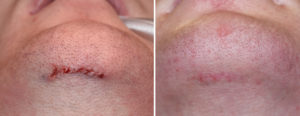Asymmetry of the chin is not common and is almost always due to the bone. Since the lower jaw is formed embryologically by paired arches coming together in the midline at the chin it would not be surprising that occasionally the two half are not perfectly equal creating a bony asymmetry. (congenital chin asymmetry)
But more commonly amongst this uncommon chin problem is that the asymmetry occurs from trauma. Falling on the chin at a young age potentially creates a small subperiosteal hematoma. Blood under the periosteum, particularly at a young age, is a stimulus for bone growth. This can create an inferior bump of bone that creates the chin asymmetry. (iatrogenic chin asymmetry)
Surgical treatment of a bony chin asymmetry can be done from either an intraoral mucosal or submental skin approach. Successful results can usually be achieved with either technique in most cases.
The submental approach has the advantage that it offers a direct line of sight to treat the problem since the bony excess is mainly on the lower edge of the chin. (inferior border) This allows an inferior view of the bony chin so that both the vertical and horizontal views of the chin bone can be optimally seen.

Differing lengths of the chin are very visible and are most commonly caused by a bony difference. They stand out because of the inferior border line of the jaw that runs from side to side. Shaving of the elongated side leads to improved chin symmetry. If a slight submental scar is acceptable the inferior approach is a reliable technique that avoids any intraoral recovery.
Dr. Barry Eppley
Indianapolis Indiana



